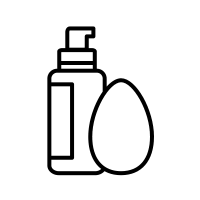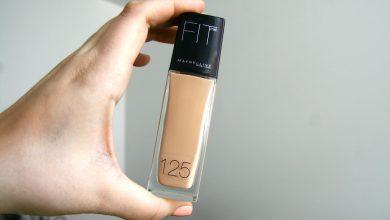How to choose and use the best concealer for you

With a concealer, skin discoloration and impurities can be covered well. Darker areas of the skin are lightened and, in combination with your foundation, ensure a more even complexion. Learn more about how to choose and use the best concealer for your skin type and problem.
Myths About Using a Concealer
Before we dive into the details of choosing and using a concealer, let’s first uncover a few persistent myths about concealer.
- Concealers are not an alternative to foundations. If you’re looking for better coverage, you can use the concealer after foundation as well. Apply the concealer only to blotchy areas of skin that differ from your actual skin (under the eyes, around the nose and on blemished skin areas).
- Omitting the foundation and using only a concealer only works if you have an almost perfect complexion and even then the concealer should match your complexion perfectly. Use it sparingly and apply very thin layers.
- It’s impossible to hide skin problems like blemishes, brown spots, or reddish moles without seeing that you’ve used makeup. Even the best concealers have their limits.
Recommendations for choosing the right concealer
Choose a concealer that is tailored to the needs of your skin type and skin problem. Follow these guidelines:
- Are you prone to dry skin? Then you should avoid a liquid concealer with a matte finish, as this could add to the dryness.
- If you are prone to oily skin with enlarged pores, it is better not to choose a concealer with a creamy texture or in the form of a pencil. The texture of such concealers could clog your pores and make your skin look shiny.
- If you want to cover dark circles and brown or red spots, choose a concealer with medium to high coverage.
- When using a concealer under the eyes, you should choose a product that is only 1-2 shades lighter than your actual complexion. Your concealer should ideally be the same color as your foundation.
- If you’re prone to moderate to severe skin discoloration, consider using a concealer with more pigment. Combine it with a foundation for a natural look by mixing the concealer with your foundation to make it less visible.
- Experiment a little with colors, textures, finishes, and techniques to find out which concealer suits you best.
What types of concealers are there?
Below we’ve compiled a list of the different types and properties of concealers that are available:
LIQUID CONCEALERS
Liquid concealers are available with a semi-gloss, shimmering or matte finish. A matte finish generally lasts longer than a silky finish. However, a silky finish usually looks more natural, especially on dry skin areas. A shimmering finish works best under the eyes, as they are then nicely emphasized.
- For normal skin, combination skin, oily or sensitive skin and skin that is prone to blemishes.
- Versatile, as you can determine the level of opacity yourself.
- Very suitable for covering impurities as the product does not clump. In contrast to creamier concealers, there is very little risk that the product could aggravate imperfections.
CONCEALER CONCEALER
Available as a matte and, above all, a semi-matte shimmer finish. Both variants are long-lasting and do not tend to become brittle or run. After you have mixed the concealer with a semi-gloss finish, we recommend applying a thin layer of powder to extend the hold of the make-up.
- Has a semi-firm, creamy texture (comparable to a lipstick) and contains a lot of pigments.
- Ideal for normal, dry or sensitive skin.
- You can determine the level of opacity (from medium to full opacity) yourself
- Please note: Concealers only make blemishes worse if they contain a lot of heavy and waxy ingredients.
CREAM CONCEALER
Available as a semi-gloss or creamy finish in a small jar or palette. For medium to full coverage. Provides better coverage due to the firmer texture and special pigments.
- Ideal for normal, dry or sensitive skin.
- Choose the level of coverage for yourself, from medium to full coverage.
- Ideal for use under the eyes.
- A great option for covering up skin discolorations such as melasma (also known as a pregnancy mask) or moles.
CREAM TO POWDER CONCEALER
Usually offered as a compact powder / concealer and can be used with a sponge for a powdery, matte finish.
- Ideal for normal, slightly dry skin, combination skin or sensitive skin.
- You can determine the degree of coverage yourself, from light to medium coverage.
- Thanks to its creamy texture, it is pleasant and easy to use.
COLOR-CORRECTING CONCEALER
Use this concealer under your foundation to neutralize unnatural colors. You can also combine the concealer with a skin-colored concealer with the same finish. If the concealer has been covered with a foundation, the underlying color-correcting concealer can hardly be made out.
- Best suited for problems with the complexion (dark circles or stubborn skin redness).
- Usually offered as a cream or stick. The liquid variant is often transparent or can be easily made transparent by mixing.
- You can determine the degree of coverage yourself, from transparent to full coverage.
Be careful that covering up a skin problem does not create a new one. Greenish concealers cover reddened skin well, but can also leave a green sheen under your foundation. It’s best to practice something to get flawless results.
Which color-correcting concealer should I use?
Choose your color according to what you want to cover:
- Lavender: corrects a dull or yellowish complexion
- Yellow: corrects dark purple shades such as dark circles or scars
- Pale yellow: accentuates the arch of the browbones and the cheekbones
- Green: neutralizes redness (including rosacea-related)
- Pink: neutralizes a bluish sheen on light skin
- Orange or salmon: neutralizes dark, purple or gray shades on darker skin
How do I use a concealer?
Whichever type of concealer you choose, the way you use it is more or less the same. These are the main points to look out for:
- Are you prone to dry skin, especially around the eyes? Then you can first apply some moisturizer , let it soak in briefly and then use the concealer.
- Better not to use your concealer over a powdery foundation. This could streak or make the powder look lumpy. Always use the concealer first when using a powdery foundation.
- A concealer that is 1-2 shades lighter than your complexion is sufficient to neutralize darker skin spots in a subtle way.
- Use your clean fingertip, a brush or sponge and dab the concealer on the appropriate blemishes until you can no longer see the transition between the concealer and the skin or foundation.
- Apply a touch of loose powder or compact powder over the concealer to extend the hold of the makeup.
- Better not to use a matte finish powder after applying the concealer, as it may make your skin look dry and the concealer may feel dry as a result. Experiment a little to see what looks best: with or without powder.
- Are you using a concealer under your eyes? Then try a concealer with a satin finish or a bright highlighter. These reflect the light and hide the darker areas of the skin even better. Note, however, that a glowing highlighter is not always the best option for wrinkles as it can accentuate them.




